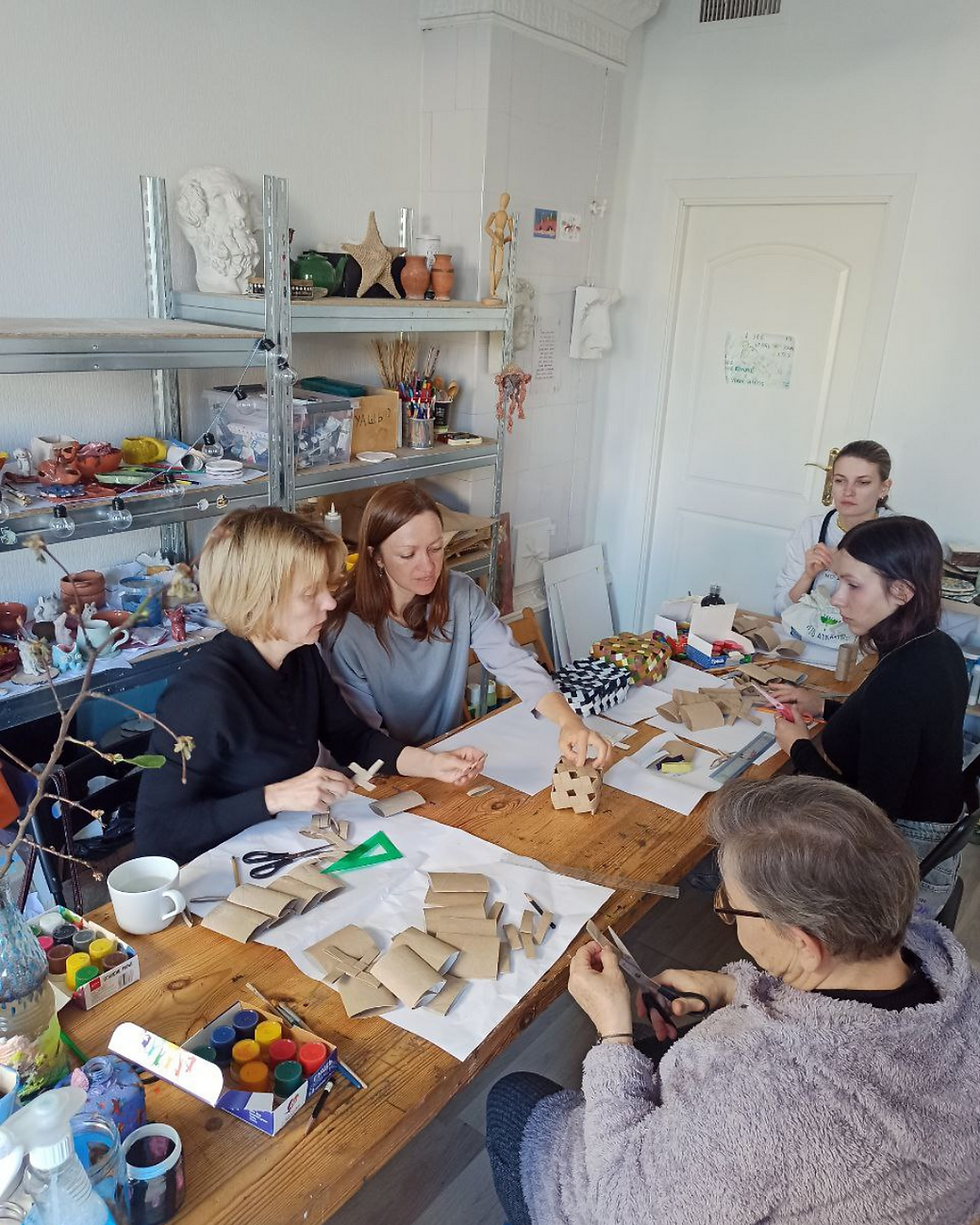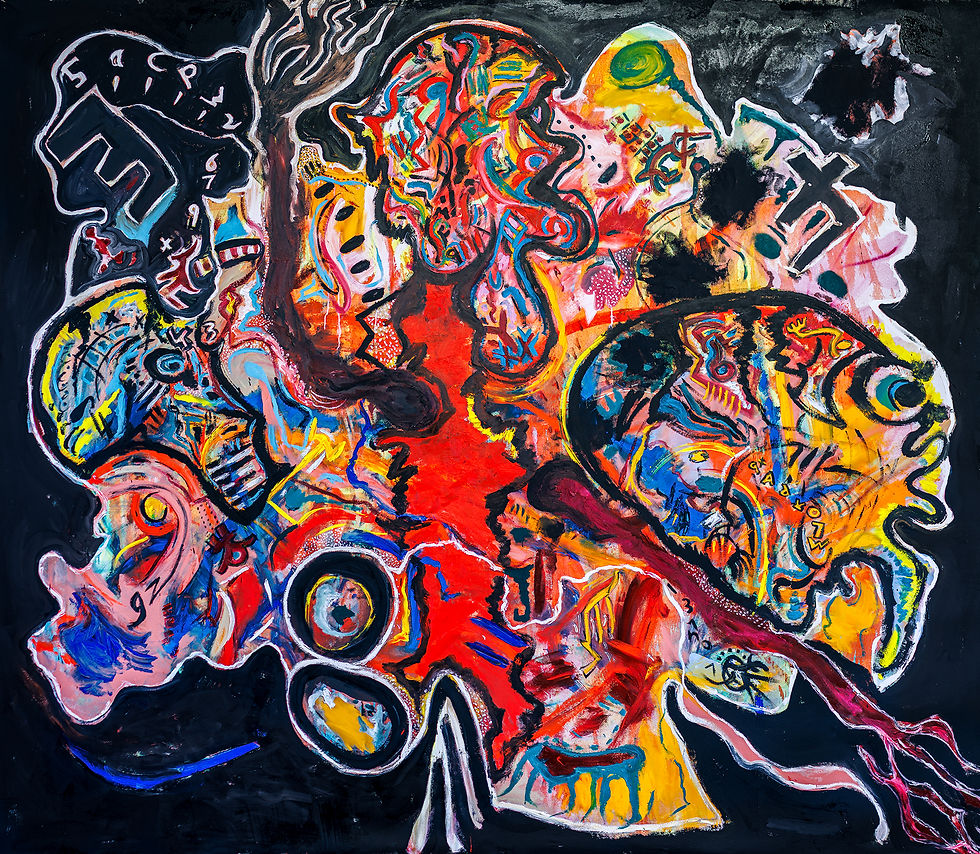Media Platform &
Creative Studio
Online Residency - Profiles
Evgenija Ivanova
Joana Alarcão
Meet Evgenija Ivanova, a Latvian eco-artist whose practice transforms the overlooked materials of everyday life—fallen leaves, delicate petals, discarded branches, and toilet paper rolls—into vibrant meditations on sustainability and our connection to the natural world.
During her residency, Evgenija developed five distinct series that challenge conventional boundaries between art materials and nature. Fragile flower petals are transformed into translucent color fields, while leaf compositions create intricate woven paintings that speak to pattern, texture, and organic structure. Branches become colorful sculptures, moss transforms into wall paintings, and cardboard tubes from toilet paper rolls are reimagined as functional baskets through community workshops—each work demonstrating that discarded materials hold untapped potential for beauty and meaning. Through her art and teaching, Evgenija offers a quiet but clear message: sustainability begins with recognizing that nothing is truly waste, only material waiting for transformation.
7 October 2025



Evgenija Ivanova (born 1987, Latvia) graduated from the Architecture Faculty at Riga Technical University in 2011 and completed her teacher qualification at the University of Latvia in 2023.
She has worked as an art teacher for 4 years and actively volunteers with the NGO “Young Folks LV” in Riga, leading creative workshops in mandala painting, basket weaving, mosaic, and collage.
Evgenija continues to grow as an artist. With a strong background in traditional drawing and painting, she is now exploring eco-art as part of the IOAEA sustainable art residency. She is also developing a mosaic mural project and painting mural artworks.
Artist Statement
As a visual and eco-artist, Evgenija brings together art and ecology. She creates artworks from natural and recycled materials to connect people with nature and inspire sustainable living.
Through workshops and community projects, she invites people of all ages to explore creativity using tree leaves, branches, colored sand, magazines, and even toilet paper rolls.

Can you briefly introduce yourself and your artistic practice? What steps did you take to become the visual and eco-artist you are today?
I am Evgenija (Riga, LV) artist and art teacher with a strong background in traditional academic art. I started actively drawing during my architecture studies and have been painting with different materials like oil paints, watercolors, acrylics, and oil pastels. Later, I began experimenting with other materials like mosaics, colored sand, natural and recycled materials. Step by step, I moved from traditional art to eco‑art, adding workshops and community projects.
Your background in architecture from Riga Technical University provides a unique foundation for your current eco-art practice. How has your architectural training influenced your approach to working with natural materials and creating sustainable art?
Architecture taught me structure, composition, and thinking about space. Now I use these skills when planning artworks with natural materials.

What motivated you to apply and participate in this online program? What were your initial goals and expectations?
The idea of using materials that are not bought in the shop always appealed to me. I wanted to explore eco‑art world, the challenges of working with natural materials. Get new ideas for artworks, and I also hoped to connect with others who care about nature and art.
During the residency, you developed five distinct series of paintings and sculptures from natural and recycled materials with the aim of connecting people with nature and inspiring sustainable living. Could you elaborate on the overall conceptual and material framework behind these works?
During 6 weeks of residency, I have worked with leaves, flower petals, branches, moss and recycled materials. I enjoy exploring the unusual sides of materials that people usually do not think of. Leaves forming weave painting, flower petal colors talking about Rothko masterpieces, branches becoming colorful sculpture, moss making a wall painting. As nature can form unexpected shapes and uses, waste can also be transformed into art that brings joy and makes people think about sustainability. Community workshops on creating baskets from toilet paper and cardboard rolls had a great success.

One of your series is called Rothko-inspired, where you create paintings out of leaves and flowers. Can you discuss the specific choices you made in selecting these materials, and what challenges did you encounter while working with such fragile materials?
I chose leaves and flowers for their color and texture. The biggest challenge was working with petals, because they are very fragile and delicate, but at the same time delivered brighter and translucent results. Leaves are more comfortable in use, but the color range is more limited. I enjoyed experimenting with both and will continue using them in my future art experiments.
Another aspect of your practice is also teaching, working with people of all ages in workshops using everything from tree leaves to toilet paper rolls. What do you observe happens when participants—especially children—first encounter the idea that "waste" can become art?
I volunteer at youth centers with art workshops. It is my playground to explore more deeply the art experiments I am currently working on. Offering unusual material to participants often brings unexpected results and surprises to me as an artist. And at the same time opens a new world to them showing that old things can have a new life. And, hopefully, the Earth will become a bit more sustainable.

Your practice involves direct, tactile engagement with natural materials—touching leaves, handling branches, working with petals. In our increasingly digital world, what do you think this kind of material intimacy offers people?
Being in nature gives us peace and calmness. It starts already from going out to collect leaves and branches. Afterwards, when the artistic journey begins, one starts to discover each leaf separately, rotating each branch and finding its best use. Being directly in touch with nature, one returns to the idea that people are also part of nature.
Can you share an example of how you and your fellow artists inspired or learned from each other during the collaborative process?
Working within a group was extremely helpful, also because we are coming from different artistic areas, like theater, installations, visual art and community work. We shared our visions and knowledge, which often opened new horizons for others. It’s also exciting, curious and useful to follow the artistic journey of others.

How has your perspective on the role of art in promoting environmental protection evolved over time, and what advice would you give to emerging artists who are passionate about environmental issues?
I see art as a gentle way to make people care more about nature. My advice: start small, use what you have, and let your art carry a clear message.
If you could give one piece of advice to future participants of this program, what would it be?
Be open, try new things, and share all your ideas with others – sometimes an unexpected word or thought will bring you to a bigger insight. Also, keep structure and discipline.
Know more about the artist here.
See the immersive virtual exhibition here.
All images:
Serene. Dried leaves on cardboard, 2025. By Evgenija Ivanova.
All images courtesy of Evgenija Ivanova.







